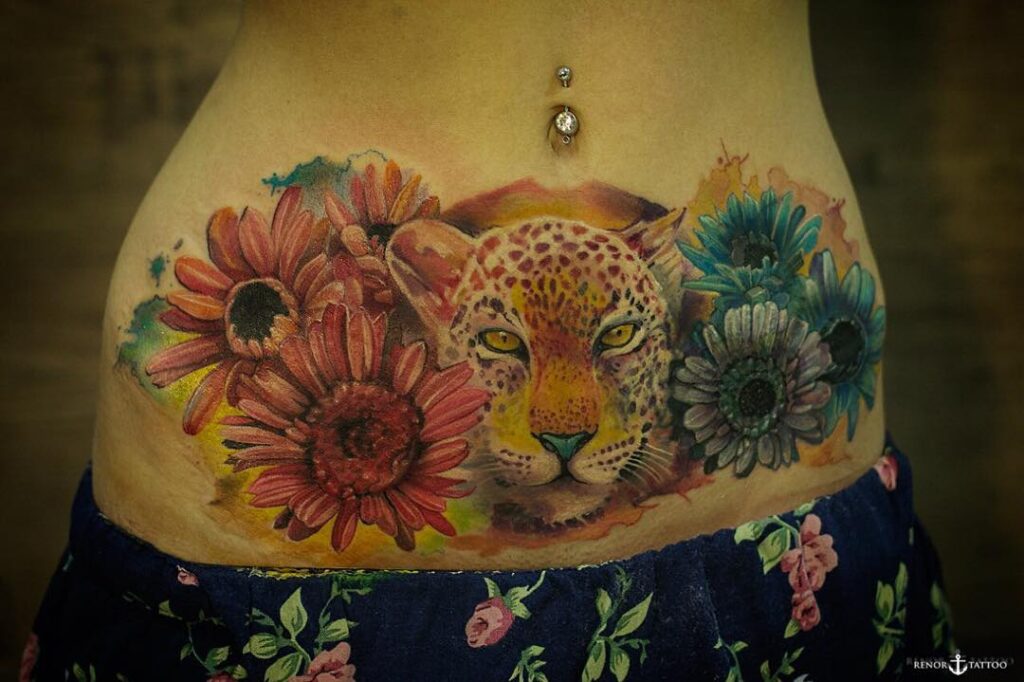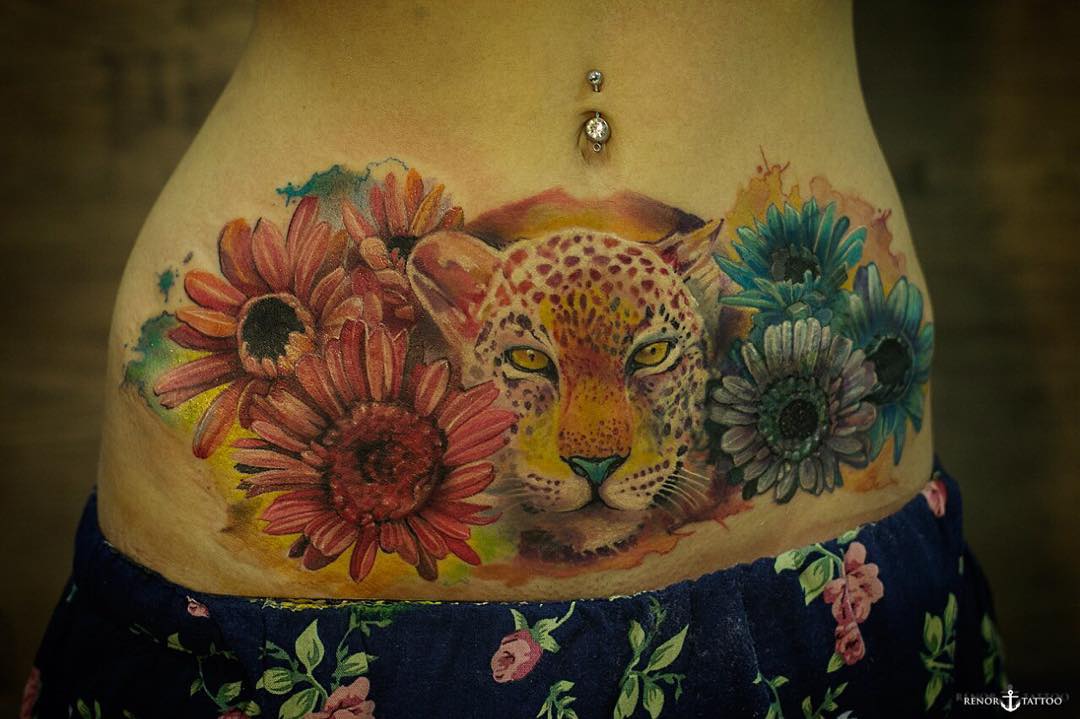
Stomach Tattoos: Ideas, Designs, Pain Levels, and Aftercare
The stomach, a canvas often hidden yet deeply personal, has become an increasingly popular location for tattoos. Whether it’s a subtle design tracing the lower abdomen or a bold piece covering the entire area, stomach tattoos are a powerful form of self-expression. This article delves into the world of stomach tattoos, exploring design ideas, pain considerations, the healing process, and essential aftercare tips. We aim to provide a comprehensive guide for anyone considering getting inked on their midriff.
Why Choose a Stomach Tattoo?
The reasons for choosing a stomach tattoo are as varied as the designs themselves. For some, it’s about reclaiming their body after significant life events like childbirth or weight loss. A stomach tattoo can be a symbol of strength and resilience. Others opt for this location because it offers a larger canvas for intricate designs, allowing for greater artistic freedom. The ability to conceal the tattoo easily, depending on the placement and size, is also a significant draw for many.
Popular Stomach Tattoo Ideas and Designs
The possibilities for stomach tattoos are virtually endless. Here are some trending ideas:
- Floral Designs: From delicate vines winding around the navel to elaborate bouquets spanning the entire stomach, floral stomach tattoos are a classic choice, often symbolizing beauty, growth, and femininity.
- Geometric Patterns: Clean lines and symmetrical shapes create visually striking and modern stomach tattoos. Mandalas, sacred geometry, and tribal patterns are all popular options.
- Animal Motifs: Animals can represent various qualities and characteristics. Lions symbolize courage, butterflies represent transformation, and snakes can signify rebirth. Choosing an animal with personal significance can add depth to your stomach tattoo.
- Quotes and Script: Meaningful quotes, song lyrics, or personal mantras can be powerful reminders etched onto your skin. Choose a font that complements the message and consider the placement carefully.
- Abstract Art: For those seeking a unique and unconventional look, abstract stomach tattoos offer a chance to express themselves through colors, shapes, and textures.
- Underboob Tattoos: While technically not *on* the stomach, these tattoos often extend down onto the upper abdominal area and are a very popular choice.
Placement Considerations
The placement of your stomach tattoo can significantly impact its appearance and meaning. Consider these factors:
- Size and Shape: Larger designs require more space and may be better suited for the lower abdomen or the entire stomach area. Smaller, more delicate designs can be placed near the navel or along the hip bones.
- Concealability: Think about how easily you want to be able to hide your tattoo. Lower abdomen tattoos are generally easier to conceal than those that extend higher up the stomach.
- Body Shape: The natural curves and contours of your body can influence the way a tattoo looks. Work with your artist to choose a design that complements your physique.
Pain Levels: What to Expect
Pain is a subjective experience, but generally, stomach tattoos are considered to be moderately painful. Several factors contribute to the level of discomfort:
- Proximity to Bone: Areas closer to the ribs or hip bones tend to be more sensitive.
- Nerve Endings: The stomach area has a high concentration of nerve endings, which can amplify the pain.
- Skin Sensitivity: Individual pain tolerance varies, and some people are simply more sensitive to tattooing than others.
- Size and Complexity of the Design: Larger and more intricate tattoos require longer sessions, which can lead to increased pain and fatigue.
To manage the pain, consider these tips:
- Choose an Experienced Artist: A skilled artist will be able to work efficiently and minimize trauma to the skin.
- Stay Hydrated: Drinking plenty of water before and during your appointment can help keep your skin hydrated and more receptive to the ink.
- Avoid Alcohol and Caffeine: These substances can thin your blood and increase sensitivity.
- Take Breaks: Don’t hesitate to ask for breaks during long sessions.
- Use Numbing Creams: Consult with your artist about the possibility of using a topical numbing cream to reduce pain.
The Healing Process: What to Expect
The healing process for a stomach tattoo typically takes 2-4 weeks, but it can vary depending on individual factors and the size of the tattoo. Here’s a general timeline:
- Days 1-3: The tattoo will be tender, red, and slightly swollen. You may experience some oozing of ink and plasma.
- Days 4-7: The tattoo will begin to scab over. Avoid picking or scratching the scabs, as this can damage the tattoo and increase the risk of infection.
- Days 7-14: The scabs will start to flake off naturally. The skin underneath may appear shiny and slightly discolored.
- Weeks 2-4: The tattoo will continue to heal, and the skin will gradually return to its normal appearance.
Essential Aftercare Tips for Stomach Tattoos
Proper aftercare is crucial for ensuring that your stomach tattoo heals properly and looks its best. Follow these tips:
- Keep the Tattoo Clean: Gently wash the tattoo with mild soap and water 2-3 times a day. Avoid using harsh soaps or scrubbing the area.
- Apply a Thin Layer of Aftercare Ointment: Use a fragrance-free, hypoallergenic ointment recommended by your artist. Apply a thin layer after each washing.
- Avoid Sun Exposure: Protect your tattoo from direct sunlight by wearing loose-fitting clothing or applying sunscreen (after the tattoo has fully healed).
- Avoid Soaking the Tattoo: Refrain from swimming, taking baths, or using hot tubs until the tattoo is fully healed.
- Wear Loose-Fitting Clothing: Avoid tight clothing that can rub against the tattoo and irritate the skin.
- Stay Hydrated: Drinking plenty of water helps keep your skin healthy and promotes healing.
- Listen to Your Artist’s Instructions: Your artist will provide specific aftercare instructions based on your individual tattoo. Follow their advice carefully.
Potential Risks and Complications
While stomach tattoos are generally safe, there are some potential risks and complications to be aware of:
- Infection: Improper aftercare can lead to bacterial or fungal infections. Signs of infection include redness, swelling, pain, pus, and fever. Seek medical attention immediately if you suspect an infection.
- Allergic Reactions: Some people may be allergic to certain tattoo inks. Allergic reactions can cause itching, rash, and swelling.
- Scarring: Picking or scratching the tattoo can lead to scarring.
- Fading: Tattoos can fade over time due to sun exposure, improper aftercare, and natural aging.
- Stretching: Significant weight gain or loss can stretch the skin and distort the tattoo.
Finding the Right Tattoo Artist
Choosing a reputable and experienced tattoo artist is essential for a successful stomach tattoo. Look for an artist who:
- Has a Strong Portfolio: Review their previous work to ensure that their style aligns with your vision.
- Is Licensed and Insured: This ensures that they meet the necessary safety standards.
- Maintains a Clean and Sterile Environment: The studio should be clean and well-maintained, and the artist should use sterile equipment.
- Communicates Effectively: They should be willing to listen to your ideas, answer your questions, and provide guidance.
- Is Experienced with Stomach Tattoos: Some artists specialize in certain areas of the body. Choose an artist who has experience with stomach tattoos.
Getting a stomach tattoo is a significant decision that requires careful consideration. By understanding the design options, pain levels, healing process, and aftercare requirements, you can ensure a positive and rewarding experience. Remember to choose a reputable artist, follow their instructions, and take good care of your tattoo to enjoy it for years to come.
[See also: Tattoo Aftercare: A Comprehensive Guide]
[See also: Pain Management During Tattooing: Tips and Techniques]
[See also: Choosing the Right Tattoo Artist: A Step-by-Step Guide]

